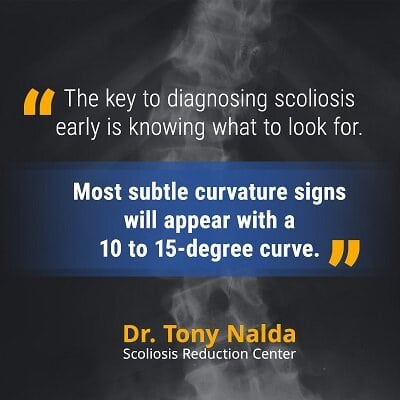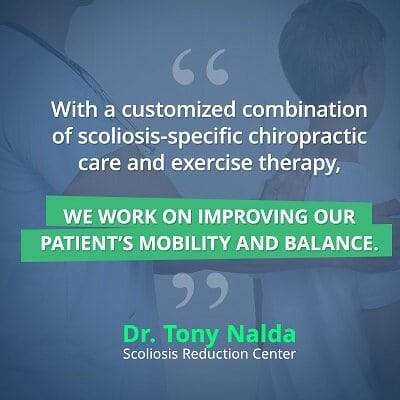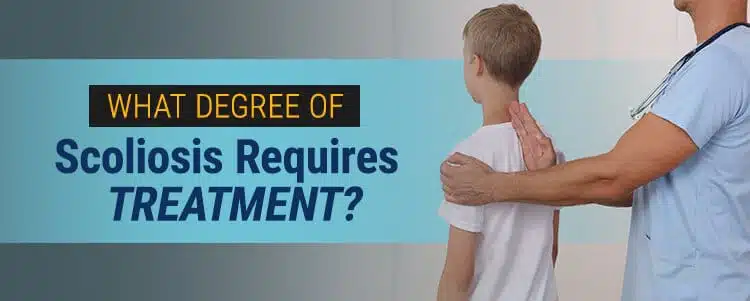Determining what degree of scoliosis requires treatment is a complex issue. This is because there are two main approaches to treating the condition and they differ widely. On one hand, there’s the traditional approach that most often doesn’t start treatment until a curvature has reached or progressed past 25 degrees; on the other, there’s my chiropractic-centered functional approach that initiates treatment as close to the time of diagnosis as possible.
Understanding How a Spinal Curvature is Measured
Scoliosis is a condition characterized by a sideways curvature of the spine that coincides with spinal rotation. I describe it as a 3-D condition, and we’ll return to that characteristic and why it’s important in terms of treatment shortly.
Mild-to-Severe Scoliosis
A scoliosis diagnosis ranges from mild to severe. A mild classification would include a spinal curvature measuring up to 25 degrees. A severe designation: a curvature that is measured at 40 degrees or more.
Cobb Angle
Scoliosis classification is given by measuring the side-to-side spinal curvature, referred to as the Cobb angle. This angle is the maximum distance between a straight spine and a curvature. In most cases, it will take at least a 10-degree deviation from straight to be diagnosed as scoliosis.
X-Rays to Measure and Monitor
Standing X-rays taken of the spine from the back and side will measure the degree of a spinal curvature and place it on the spectrum of mild-to-severe scoliosis.
The traditional approach relies heavily on the use of X-rays to monitor a curve’s progression, but I find there’s a shortcoming to relying so heavily on X-rays as it provides only a 2-D measurement of a 3-D condition. Also, during growth spurts, the time in-between X-rays can be too long.
Don’t get me wrong, I rely on X-rays too; they are an instrumental part of diagnosing and monitoring the condition. I combine X-ray results with a number of other standing and seated measurements taken from multiple angles and positions to ensure I am getting full 3-D measurements of the condition. Keeping a close watch on a patient’s posture is also a large part of my monitoring strategy.
Diagnosing Scoliosis Isn’t Easy
A lot of the mystery that still surrounds scoliosis is because of how difficult it is to diagnose. In many cases, a scoliosis diagnosis is accidental. A person will be getting an X-ray for another reason, and the doctor notices a curvature.
Adolescent scoliosis is the largest group of diagnosed scoliosis patients. In most cases, it is a painless condition. By the time noticeable changes to the posture have developed, the curvature has progressed significantly.

If the condition was more painful in adolescents, it would be easier to diagnose as parents and caregivers would be poking around looking for a source of the pain and a way to stop it.
The key to diagnosing scoliosis early is knowing what to look for. Most subtle curvature signs will start to appear with a 10- to 15-degree curve. Unless you’re a scoliosis specialist or are constantly on the watch for symptoms, it’s hard to diagnose.
Symptoms to look for:
- Asymmetries of the shoulders, hips, and waistline
- Arms that hang differently
- Rib hump
- Torso lean
- Head appearing uncentered
Traditional Treatment
The traditional treatment approach would start when a curve reaches or progresses past 25 degrees. My issue with this course of treatment is that at 25 degrees, a patient is already 15 degrees from a surgical-level curve.
Most often, it is recommended that X-rays are taken every three-to-six months to watch and wait to see if the spinal curvature is progressing and at what rate. The danger of watching and waiting, especially in cases of adolescent scoliosis, is that a huge growth spurt can occur between X-rays, resulting in rapid curvature progression and further funneling patients towards surgery.
Often, braces will be suggested as part of traditional treatment. This is a tight brace that is worn over the upper body that holds the spine in a straighter alignment with the goal of preventing the curve’s progression. While there has been much success with this form of treatment, often the time between ordering the brace and its arrival can measure in months, during which time the curvature could be progressing unimpeded during a pubescent growth spurt.
There is also the issue of how wearing a traditional brace for 13+ hours a day will affect the mindset, happiness, and confidence level of the average adolescent facing scoliosis. This also involves restrictions placed on physical activity.
The traditional treatment approach is a passive one. It involves a lot of, “Let’s wait and see what happens.” To that, I would like to remind people that there’s no harm in working towards a reduction immediately as no one is going to simply outgrow an abnormal spinal curvature.
The traditional approach that funnels patients towards intensive spinal-fusion surgery is firmly entrenched in the condition’s treatment history, and I think a part of that is because it plays on the hopes of patients and their caregivers that things will improve on their own or that surgery will cure scoliosis. Realistically, there is no known cure for scoliosis, only ways to manage it and prevent its progression.
Fortunately, there are other well-established forms of treatment that are successful in slowing a curvature’s progression, achieving a reduction, and allowing patients to live their best lives while doing so.
Alternative Chiropractic-Centered Functional Approach
My alternative treatment option is a chiropractic-centered functional approach. Patients and their caregivers find success with my approach because, here at the Scoliosis Reduction Center®, we offer a customized approach with access to multiple facets of treatment in one place:
- Scoliosis-specific chiropractic care
- Exercise therapy
- Rehabilitation
- Custom 3-D bracing
How My Approach is Different
My approach is different because I take into account how any chosen course of treatment affects the whole patient. Our scoliosis-specific chiropractic care, exercises, and rehabilitation work together to strengthen the spine in a corrective position, making it harder for a curvature to progress. The ultimate goal is to achieve a reduction and slow or stop the condition’s progression, and I take a functional approach that encourages staying active and mentally healthy throughout treatment.
People with Scoliosis can Live Their Best Lives
The reality is that people with scoliosis will be living with the condition for their entire lives. We want those patients to be able to live their best lives. Through a lot of hard work and dedication, we can help them achieve that. Through engagement with their treatment and building as positive an association with their condition as possible, our patients are able to regain feelings of control over their lives and their bodies.
We don’t watch and wait; we diagnose and start treatment immediately. I feel there’s more harm to watching and waiting than there is to initiating a patient-centered form of treatment immediately.

My treatment approach diverges from the traditional approach by focusing on maintaining functionality and encouraging my patients to not let their condition stand in the way of their passions and goals.
With a customized combination of scoliosis-specific chiropractic care and exercise therapy, we work on improving our patient’s mobility and balance. We actually encourage our patients to keep doing the physical activities they love. We want our treatment to facilitate a healthy lifestyle and shape it around how well it allows our patients to maintain the physical activities they love.
We work closely with our patients and their caregivers to decide which treatment options are best for them. Custom 3-D bracing has its place, but we make sure that it doesn’t come at the expense of the patient’s mindset or quality of life. Out treatment plans prioritize strengthening the spine through natural means, rather than holding it with a brace or rod.
Choosing a Treatment Path
It’s one thing for an adult patient to come to me seeking ways to manage the pain related to their scoliosis or seeking new treatment options; it’s quite another for parents and caregivers who are advocating for their loved ones and have the added pressure of trying to decide which treatment option is best for them.
The sad thing is that by the time I meet many of my patients, they have been on the path of traditional treatment and are already headed towards surgery. These cases are the hardest for me because I hear so often, “I wish I had known about you and your approach earlier.”
I can’t tell you how many parents and caregivers I’ve seen in tears because they so strongly regret the fact that instead of acting immediately, they took the dominant medical advice to watch and wait.
If I could turn back time for these patients, I would. I would turn the clocks back to that initial diagnosis, in the doctor’s or specialist’s office, and I would start the treatment clock that very day.
I’m not here to say I have the only effective scoliosis-treatment approach, but obviously, I do strongly believe that my approach is the best chance patients have of avoiding painful surgery and the risks and limitations that come with it. I do believe that my patient-centered customized approach treats the whole patient by taking into account the many different levels of a person’s life that are impacted by the condition.
Conclusion
To return to the original question of what degree of scoliosis requires treatment, by now you know that the answer will change depending on the approach you’ve chosen. The traditional approach would dictate that intensive treatment starts after a 25-degree curvature and most often ends with spinal-fusion surgery; my chiropractic-centered treatment would say any degree of scoliosis, once it is diagnosed, is best managed with immediate treatment.
I’m thrilled with what my team at the Scoliosis Reduction Center® has accomplished. In as little as two weeks, 98 percent of our patients show improvements in relief and function. Our approach involves ingenuity and dynamic thinking. We include each and every patient and caregiver in customizing a treatment plan that will align most effectively with that patient’s quality of life. We want our patients to engage with their condition, not be ruled by it.





